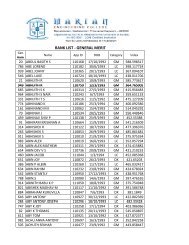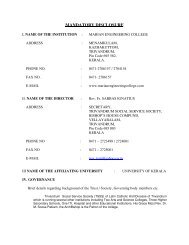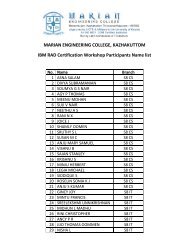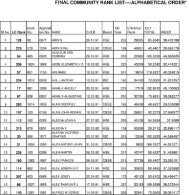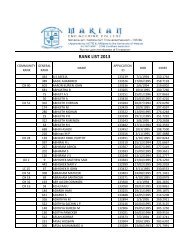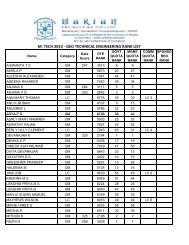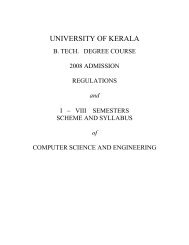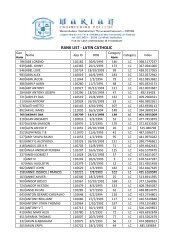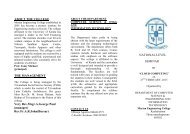UNIVERSITY OF KERALA - College of Engineering, Trivandrum
UNIVERSITY OF KERALA - College of Engineering, Trivandrum
UNIVERSITY OF KERALA - College of Engineering, Trivandrum
Create successful ePaper yourself
Turn your PDF publications into a flip-book with our unique Google optimized e-Paper software.
08 606.5 Elective II TRAFFIC ENGINEERING<br />
L T P/D Cr<br />
3 1 0 4<br />
Module I<br />
Traffic <strong>Engineering</strong>: Definition, Functions.<br />
Road User, Vehicle and The Road: Human factors governing road user behaviour - Vehicular characteristics.<br />
Traffic Surveys: Speed, Journey time and delay study – Methods-Moving observer method, Presentation <strong>of</strong><br />
data- grouping <strong>of</strong> speed data, cumulative frequency curve, problems. Vehicle volume counts and classifications<br />
- methods Parking surveys. Uses <strong>of</strong> photographic techniques in traffic survey.<br />
Origin- Destination Surveys- methods, zoning and presentation <strong>of</strong> results.<br />
Module II<br />
Traffic Controls: Different types <strong>of</strong> traffic signs and markings. Traffic signals - design, coordinated signalstime-distance<br />
diagram -area traffic control-Other traffic control aids and street furniture.<br />
Intersections And Interchanges –Types-Planning and layout<br />
Traffic Safety: Accidents-causes and prevention.<br />
Parking: Zoning and parking space requirements-On street and <strong>of</strong>f street parking.<br />
Traffic Management-Concept and techniques.<br />
ITS, GIS And GPS- Introduction to Intelligent Transportation Systems, Geographic Information System and<br />
Global Positioning System<br />
Street Lighting- Necessity, methods, arrangement- at carriageways, T, rotary, bend, bridge, tunnels.<br />
Module III<br />
Highway Capacity And Level Of Service: Definitions - PCU-LOS concept, Factors affecting capacity and<br />
LOS. Capacity <strong>of</strong> highways, urban streets, rotary, weaving sections and intersections.<br />
Theory Of Traffic Flow: Fundamental diagram <strong>of</strong> traffic flow-Relationship among the variables.<br />
Reference:<br />
1. Traffic <strong>Engineering</strong> & Transport Planning- Kadiyali L R, Khanna Publishers.<br />
2. Traffic Planning and <strong>Engineering</strong>- Hobbs, F .D., Pergamon Press<br />
3. Traffic <strong>Engineering</strong>- Mc. Shane, William R., Roess, Roger P., Prentice Hall ,New Jersey.<br />
4. An Introduction Transportation <strong>Engineering</strong> - Jotin Khisty C., Kent Lall B., Prentice Hall.<br />
5. Principles <strong>of</strong> Transportation <strong>Engineering</strong> - Partha Chakraborthy, Animesh Das, Prentice Hall India.<br />
6. Recommended Practice for Traffic Roataries - IRC 65-1976<br />
7. Guidelines for capacity <strong>of</strong> roads in rural areas -IRC 64-1990<br />
8. Traffic studies for planning By-passes around towns -IRC 102-1988<br />
9. Guidelines for Capacity <strong>of</strong> Urban roads in plain areas- IRC 106-1990<br />
10. Guidelines for design and installation <strong>of</strong> Road Traffic Signals -IRC 93- 1985<br />
11. Road accident forms- IRC 53-1982.<br />
12. Traffic Census on Non-urban roads -IRC 9-1972.<br />
Question paper:<br />
Duration: 3 Hrs.<br />
The question paper consists <strong>of</strong> Part A and Part B.<br />
Part A is for 40 marks. There will be 8 compulsory short answer questions <strong>of</strong> 5 marks each covering the entire<br />
syllabus .<br />
Part B is for 60 marks. There will be two questions from each module. The candidate has to answer one<br />
question from each module.<br />
Note: No charts, tables, codes are permitted in the Examination hall .If necessary relevant data shall be given<br />
along with the question paper by the question paper setter.<br />
63



